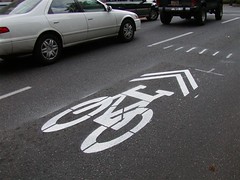These roadway markings in Northwest Portland are known as shared lane markings, or sharrows. They were installed back in September as an experimental project, and they’re still awaiting official sanction.
Because the markings are still new to many road users, the City of Portland has developed a list of frequently asked questions. They’re not available anywhere online yet, so I’ve gotten permission to publish them here:
Bicycle lane markings have shown up in the middle of the street. Can I still drive there?
If there is not accompanying white stripe with the marking then it is not a bicycle lane. What you’re seeing is a shared lane pavement marking, also known as a “sharrow.” You may still drive in that travel lane.
What are sharrows?
Sharrows are short-hand for “shared lane pavement markings.” The indicate that motorists and cyclists are to share the travel lane.
Most streets in Portland are shared by cyclists and motoriss and don’t have sharrows. Why mark only some streets?
Most Portland streets carry low volumes of traffic with relatively slow speeds and special markings aren’t needed. We are placing sharrows only on streets where traffic is relatively heavy, speeds are a little higher, and the streets should be marked with bicycle lanes but cannot be because of demands for on-street parking or the number of travel lanes.
Why are these markings on the street, what is their purpose?
To create safer conditions for bicycling. In the absence of bicycle lanes on busy streets cyclists often ride too closely to parked cars. If somebody were to open a car door as a cyclist passed the cyclist could get “doored” and possibly get injured, perhaps seriously—especially if there was passing automobile traffic. Also, when cyclists stay far right in narrow travel lanes passing motorists often pass too closely to the cyclists. This is not only unnerving for the cyclist, but it also leaves little margin for error.
Why not just stripe bicycle lanes?
There would be our preference on these streets. We’re using the sharrows instead because there isn’t enough room on the street for bicycle lanes in those areas. This is typically because of a combination of a high demand for on-street parking, and the inability to either eliminate a travel lane, or narrow the existing travel lanes. It is often also either physically too difficult or prohibitively expensive to widen the roadway.
As a cyclist, what should I do in the presence of sharrows?
We’ve placed the sharrows outside of the parked car’s “door zone.” Because the travel lane is too narrow for safe side-by-side travel by a motorist and a cyclist we expect cyclists to ride through the center of the sharrow.
As a motorist, what should I do in the presence of sharrows?
Slow down and drive carefully. Because the travel lane is too narrow for safe side-by-side travel by motorists and cyclists we expect motorists to slow down and either wait for the cyclist to turn off the roadway, or wait until you can move into an adjacent travel lane.
Why not put sharrows on all busy streets?
Right now we’re using sharrows to fill in relatively short gaps in bicycle lanes. We’re also in a testing phase right now. Depending on how well they work, we may expand the use of sharrows to longer gaps on City Bikeways. Currently, our draft guidelines only allow them to be used on streets that are classified as “City Bikeways.” We can make our draft guidelines available to you if you’d like.
What do you hope to accomplish with the sharrows?
We want to create safer conditions for bicyclists on busy streets where we should have bicycle lanes but cannot. We hope to do this by moving cyclists a little further away from parked cars than they would normally ride in the absence of sharrows, and creating a little more separation between passing motorists and cyclists than would normally exist.
Do sharrows work?
They seem to. A 2003 study in San Francisco showed that in the presence of sharrows cyclists moved further away from parked cars and passing motorists moved further away from cyclists than in the absence of sharrows. California recently adopted sharrows as a standard roadway treatment, and San Francisco has already painted hundreds of them on their streets.
Will you use them on other streets?
Right now we’re testing how well they will work in Portland as part of a test that’s being monitored by the US Government’s Federal Highway Administration (FHWA). If the markings prove effective then we’ll slowly expand their use to other, similar locations that meet our guidelines.
Since sharrows don’t require removing parking or travel lanes – as often occurs with the striping of bicycle lanes – why not just use sharrows instead of bicycle lanes?
We still consider bicycle lanes to be the best treatment for creating safe and encouraging conditions for bicycling on streets with higher volumes of motor vehicle traffic because motorists are not delayed by the presence of slower-moving cyclists in front of them, and cyclists are not feeling intimidated by the presence of following motorists who wish to pass them. We will consider using sharrows only after exhausting all possibilities for installing bicycle lanes.
So there you go. Everything you ever wanted to know about sharrows. If you’ve still got a question about them, feel free to leave a comment.


